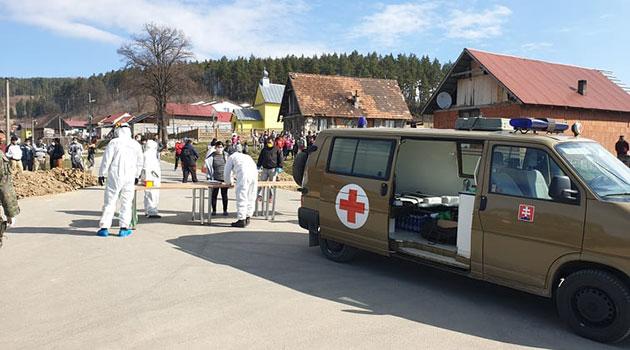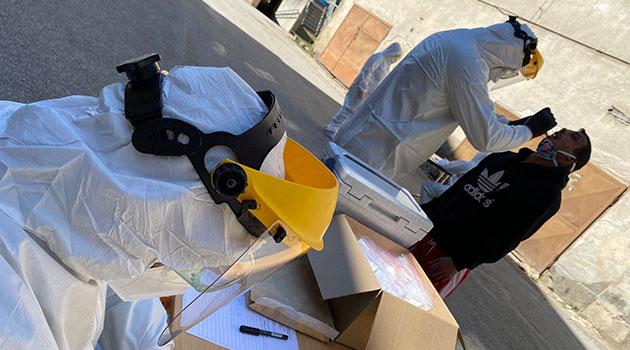Slovakia: 40 FAQs about COVID-19 testing in marginalized Roma communities

Ahead of the recent testing of some marginalized Romani people in Slovakia for COVID-19, the “Healthy Regions” program developed some answers to the frequently-asked questions about testing these people for COVID-19 and the pandemic. This extensive material covers questions of interest to people who know little or nothing about this issue; most of the questions arose after the Slovak Government began its pilot testing.
Why is this testing focusing on the Roma?
This testing is not targeting the Roma per se.
Who is the focus of this testing?
People living in Romani-inhabited ghettos and settlements, i.e., only about half of all Roma in the country.
Why does this testing focus on people living in Romani-inhabited settlements and ghettos?
Because it is not known at all whether coronavirus is present in that environment.
Why is it important to know if coronavirus is also present in that environment?
Because people live there.
Why is it not yet known whether coronavirus is present in Roma-inhabited ghettos and settlements?
Because the people who live there have not been tested yet.
Why have the people in the Romani-inhabited ghettos and settlements not been tested yet?
Because they are so socially excluded in their communities that they access most generally-available information and services either with a delay or not at all.
Why are people in the Romani-inhabited ghettos and settlements being tested at once?
Because this method of testing is the fastest.
Why is it important that people from Romani-inhabited ghettos and settlements be tested in the fastest way possible?
Because in Romani-inhabited ghettos and settlements the coronavirus will spread the fastest if it penetrates there.
Why do Romani-inhabited ghettos settlements in danger of the fastest possible spread of coronavirus if it penetrates there?
Because the living conditions in that environment make it the most difficult place in the country for people to take measures against the spread of coronavirus.
Why is the faster spread of coronavirus a problem?
Because the faster the spread, the more cases there will be at once, and the more cases there are, the more likely it is that more severe courses of the disease will happen all at once, sooner.
Why is it a problem if more severe courses of the disease happen at the same time and sooner?
Because hospitals then run the risk of not being able to help all patients with a severe course of the disease who need it, which means avoidable deaths could occur.
Why is there fear that the coronavirus might have penetrated the Romani-inhabited ghettos and settlements if they are isolated?
Because large numbers of people have continued to return home to the settlements from countries where the coronavirus pandemic has already been widespread, since the outbreak of the pandemic.
What good does testing do?
It can help prevent the spread of coronavirus by showing which people are infected – those people can then survive the disease away from home without infecting their loved ones and neighbors.
Why is it being tested for in just these 33 municipalities?
Because whenever there is a lack of information about many places, the best solution is to first get accurate information from just some of the places – so far, this has been done by the so-called pilot testing.
Why is it best to try to get accurate information from particular places first?
Because it takes a shorter time, and if the sites are chosen well, then the information gathered makes it easier to decide what is most important to investigate everywhere else (saving a lot of unnecessary work and time).
How were the municipalities selected for pilot testing?
On the basis of the information available at the time of the decision on the need to conduct pilot testing.
What information was that?
In particular, information about the estimated numbers of persons there with pre-existing conditions (based on age and other demographic data) and the numbers of families who had returned there from abroad.
Were there other preliminary lists of municipalities to be tested? Why were there others?
Yes. Other lists have gradually emerged as the numbers of returnees to individual municipalities develop over time, and because different state institutions initially started to create lists according to different dates and adding additional criteria.
Which list is the best one?
Theoretically, there could be an infinite number of “best” lists, which means virtually none is the “best” – for the purposes of pilot testing, any would serve very well.
Why are people with symptoms of influenza who have returned from abroad mainly the ones being tested?
Because they have spent most of their time in an environment where the virus has proven to have been widespread when they were there and their symptoms may be indicative of the onset of COVID-19 disease.
Why are they also testing people without symptoms?
Because they may be among those who transmit the disease without symptoms (which the majority of the infected do).
Why aren’t people outside the ghettos and settlements not being tested in this way?
Because this testing is just to find out if the virus has penetrated the settlements and reached people who have returned there from abroad.
Why isn’t this pilot testing trying to find out the same information about other places and people?
Because other testing activities in Slovakia have already focused on and continue to focus on identifying this same information in other locations.
Why weren’t people from Romani-inhabited ghettos and settlements not tested during the previously-running testing activities that are still ongoing?
Because the other testing in Slovakia is currently focusing on individuals who have been in contact with a person who has tested positively for COVID-19 or on those who already have clinical signs of the disease and is being conducted much more slowly.
What will happen to those who test positive for COVID-19 in the pilot testing in these locations?
They will have to survive their quarantine by staying away from their homes in order to keep the virus from spreading to their loved ones and neighbors. They will be quarantined regularly by their doctor, who will follow the course of their disease. If they are very unlucky and are overwhelmed by the disease, then they will go into more intensive hospital treatment. They will return home after being confirmed negative for COVID-19 by another test.
Where will the quarantines be and what will their conditions be?
This will depend on what facilities can be found and equipped for this purpose by individual municipalities, NGOs and volunteers in the coming days and weeks. In the worst case scenario, these will be state-designated facilities that will meet normal accommodation requirements with access to food, personal hygiene facilities, heating and health care.
What about the relatives of those who test positive?
They will also be tested to see if they have been infected. If they are, they will also be quarantined for treatment.
Will entire settlements be quarantined?
Only if the gradual testing reveals that more than one in 10 people are infected in a given settlement and a regional public health official decides it would be a good practice.
How many Romani-inhabited ghettos and settlements are likely to be put under total quarantine?
We will learn this after the first pilot testing finds those who have COVID-19. Test results from Jarovnice, however, show that even the largest such settlement to which many people have returned from abroad has a great chance to avoid quarantine altogether.
What would life be like in a settlement under total quarantine?
What would change would be that people would be instructed not to leave the settlement at all until the disease is cured there.
Would people in the Romani-inhabited ghettos and settlements be left to their own fate at that time?
No. Since this would be a mandatory quarantine, a situation in which even healthy people could end up because of a state decision, the state would have to take care, at its own expense, to ensure that everyone in quarantine continues to have access to food, water, basic hygiene facilities and urgent health care.
Are people from the Romani-inhabited ghettos and settlements at risk of being treated only in field hospitals?
Just those patients with very severe COVID-19 courses, and only in an exceptionally extreme case whereby ordinary hospitals would not be able to cope with patients returning from around the world. However, such a scenario is, so far, unlikely according to all the available information.
Is it planned to continue this testing in other municipalities?
This will be decided on the basis of an evaluation of the results of the ongoing pilot testing.
Why is the military participating in this testing?
Because no other institution has enough equipment and trained people immediately available to manage testing around 1 500 people in 33 villages in just a few days.
Isn’t the use of the military intimidation of the Roma, or a manifestation of racism?
Absolutely not. Although historically such concerns have been justified, this plan has been prepared by and is also implemented at the initiative of and in cooperation with the highest political representation of the Roma in the Slovak Republic and with a state organization that employs mainly Roma from the settlements. For that reason, the Army is able to conduct all the tests in the first eight villages using a minimum of materiel, and none of the tests so far has involved a single conflict or clash – all has been going very respectfully and calmly everywhere, according to all observers and commentators.
Why is the Army using helicopters during the pilot testing?
UH-60 Black Hawk helicopters are on stand-by for medical transport, for delivering swab sets, and for the collection of samples.
Why is this testing not carried out by the relevant regional authority?
The regional authority would take a significantly longer time to perform the same number of tests with its current capacities.
Why don’t health care providers serving patients in these locations do the testing?
Because for the sake of safety, this kind of direct sampling is the responsibility of specially-trained medical staff, not routine care providers.
What is the legal framework for the testing and follow-up?
Resolution 196/2020 – Plan for the management of COVID-19 in marginalized Roma communities, of 2 April 2020.
Could this testing be further improved?
Nothing is ever perfect, so certainly, yes. If you have specific suggestions on how to improve it, please contact the participating organizations through the Armed Forces of the Slovak Republic, Major Mgr. Mário Pažický, EMBA, Chief of Information Operations, Special Operations Forces.
